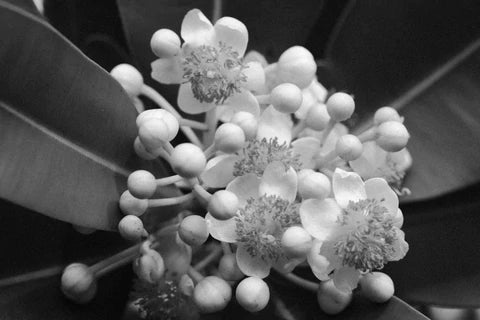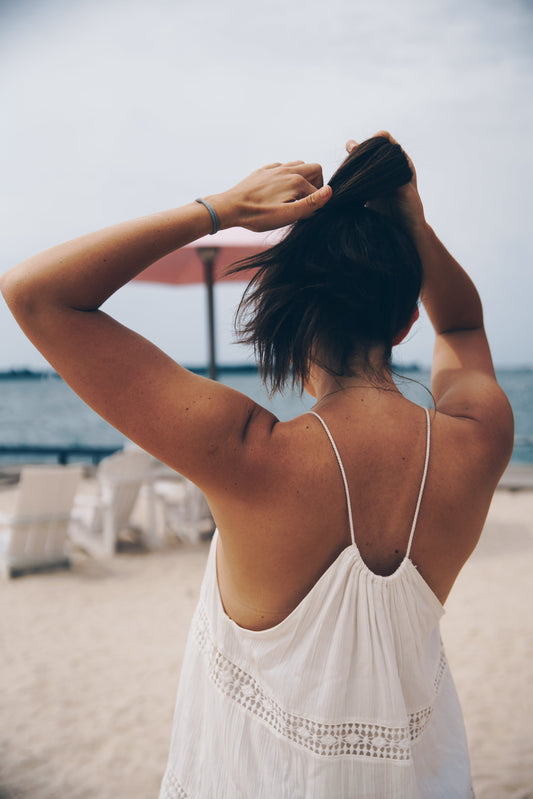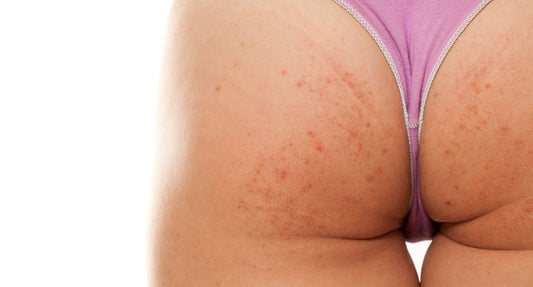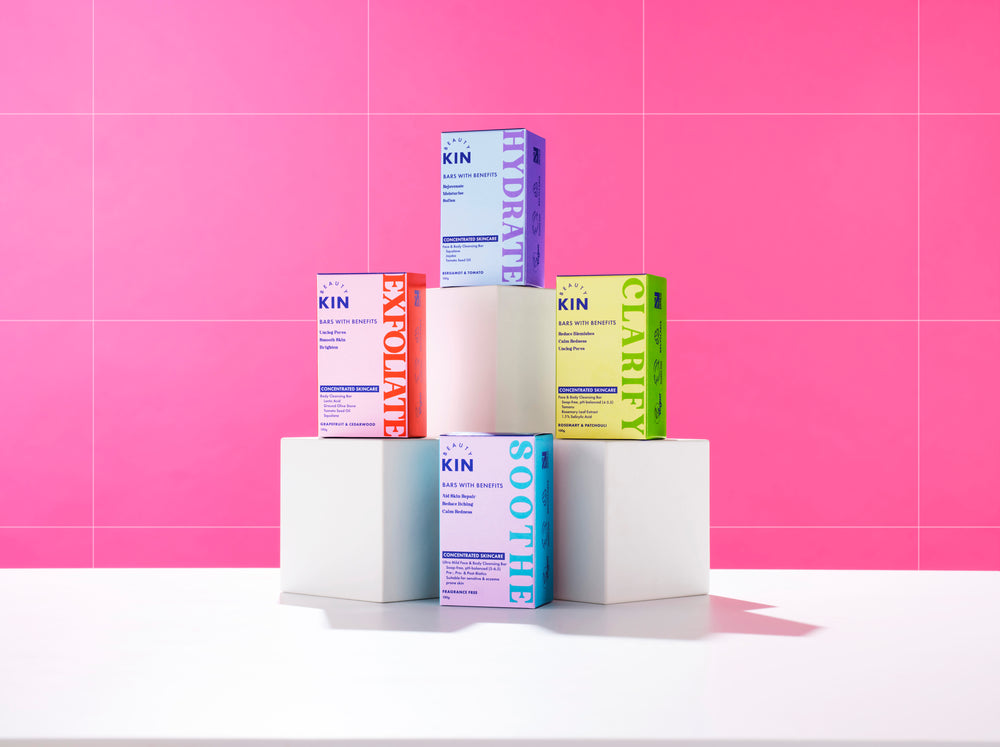Understanding & Treating Bacne
You’ve just checked into the room that will become your base for the next week, as nothing but long, sun-drenched days stretch ahead of you. You’ve been waiting for this hard-earned holiday for months and now it’s finally here. You look at the suitcase full of brand new outfits on the floor beside you but you know exactly what you’re going to change into first. That cool, blue water that you can see from your balcony is far too enticing to ignore.
As you pull your shirt over your head, you catch a rare glimpse of your back in a wall mirror. You stop and walk a little closer, keeping your neck craned as far round as is comfortable. Your back appears to be covered in patches of dead skin, spots with whiteheads, spots with blackheads and your skin seems to be pretty oily. You frown and can’t help but feel a little deflated. It seems that bacne has struck.
What is bacne?
Acne is a very common, inflammatory skin condition that can and does occur all over the body. The skin is covered in sebaceous glands, which secrete oil or sebum to stop the skin from drying out. These oil glands are connected to hair follicles, lined by skin cells called keratinocytes. In healthy skin, the sebum emerges from the pore on to the surface of the skin and the keratinocytes come to the surface and are shed.
Acne occurs when sebum, hair and keratinocytes get stuck in the pore. Therefore, the keratinocytes don’t get shed and the sebum doesn’t reach the surface of the skin. The combination of skin cells and oil means that bacteria that usually inhabits the surface of the skin grows in the follicles and causes redness and inflammation. As the clogged follicle breaks down, the sebum, keratinocytes and bacteria are released into the surrounding skin, causing spots and lesions. This is what we know as acne. The term ‘bacne’ isn’t considered an official word but it has been in popular use, when referencing acne on the back since the 1990s.
What causes bacne?
Bacne is often the result of one or more of the following causes:
- Excess oil production
- Clogged hair follicles
- Bacteria in the pores
- Skin inflammation
- Hormonal changes
- Some medications
Acne is often thought of as a ‘teenage condition’, but it can affect all ages. The reason it is more prevalent in teenagers is due to the fact that male sex hormones called androgens are boosted in both boys and girls during puberty. These hormones encourage the production of increased sebum and therefore, puberty is a significant risk for acne. Similarly, hormonal changes during pregnancy can result in acne breakouts.
There is also evidence of a genetic link for acne, so you may find that other members of your family also have the condition.
Excessive sweating is another common cause for bacne. When sweat sits on the skin for long periods of time, the pores can become clogged and this is especially common on areas such as the back.
Medication and bacne
Certain medications such as lithium, corticosteroids and hormonal drugs can exacerbate bacne flare-ups. While professionals are still theorising on why lithium triggers acne breakouts, one interesting idea is that the medication raises the levels of white blood cells called neutrophils in the body. Lithium causes neutrophils to move from the blood into the skin and cause inflammation.
Prednisone, a corticosteroid, is often prescribed to treat inflammatory conditions such as IBS and Crohn’s disease. Along with anabolic steroids, which are used for bodybuilding, they are known to cause bacne breakouts. While the reasons are still unknown, several studies suggest that steroids might enhance the production of immune system receptors called TLR2. When combined with bacteria that already lives on your skin, TLR2 receptors could well bring about a bacne attack.
Women undergoing HRT may also experience acne and this is simply due to the condition being induced by hormonal changes.
Our Clarifying body bar is completely soap-free and wants nothing more than to give you clear skin all over your body. Bacne is no match for ingredients such as neroli, salicylic acid and tamanu oil as they gently cleanse and restore your skin to full health.

Diet and bacne
If you’ve ever gone on a sugar or dairy (or both!) binge and then realised that your bacne has returned with a vengeance, it’s almost certainly not a coincidence. There is a growing mound of evidence that suggests that certain foods and diets can exacerbate acne. We know that some foods raise our blood sugar levels quicker than others. The main culprits are:
- sugar
- pasta
- white bread
- white rice
When blood sugar levels rise rapidly, a hormone called IGF-1 is produced. Excessive amounts of IGF-1 can elevate sebum production and therefore, cause acne. The above foods are considered to be high-glycemic, meaning they’re made of simple sugars. Other foods that have been found to increase sebum production are:
- dairy
- trans fats
- saturated fats
Therefore, it’s highly important to limit these food groups, if you want to keep bacne at bay.
To counteract the high-glycemic food that you certainly shouldn’t be eating excessively, low-glycemic foods include:
- whole grains
- legumes
- unprocessed fruit and vegetables
Due to the lack of simple sugars in these complex carbohydrates, they are highly likely to keep your skin clear while giving you all the energy you need for the day. Some other ingredients that are known to love your skin are:
- vitamin A
- vitamin E
- antioxidants
- zinc
These and other vital minerals for your skin and overall health can be found in:
- spinach and other leafy green vegetables
- tomatoes
- carrots
- sweet potato
- wholewheat bread
- brown rice
- quinoa
- blueberries
- nuts
- beans and lentils
- fatty fish like salmon and mackerel
Consider looking out for the above ingredients and figuring out how you can get as many of these healthy foods into your diet as possible. While we can’t say that poor diet is a direct cause of bacne, there is a lot of science that suggests it is a huge aggravator. So, it’s an excellent idea to think about whether your diet could be affecting your bacne and see what a difference a few simple changes could make.
Types of acne
Acne comes in varying degrees of severity. You may have some of these symptoms or all of them. However, they are all categorised as inflammation of the skin. The most common types of acne are:
- Whiteheads, which are closed clogged pores. They lie beneath the skin and present as a white bump.
- Blackheads, which are open clogged pores. They lie on the surface of the skin and look black because of sebum discoloration from the air.
- Papules, which are small red lumps. They can be a bit sore when touched.
- Pimples, which have white pus at the top. They are essentially papules filled with pus, so are red at the base.
- Cystic lesions, which are pus-filled lumps beneath the skin. They can be painful.
- Nodules, which are large lumps under the skin. They are often solid and painful.
All of these types of acne can occur anywhere on the body and outbreaks can severely affect your self-esteem, comfort and perhaps even your daily activities. Bacne can be especially frustrating because while you may be able to feel areas of inflammation or pain, it’s not in an area you can see or monitor as closely as acne on the face, for example. However, there are some very simple washing habits that you can get into in order to improve and even prevent acne.
Preventing acne
If acne has been a resident on your skin since you were a teenager and it’s showing no signs of moving out soon, you’ll be delighted to hear that we have some top tips for giving it the boot forever.
- Use an oil-free, non-comedogenic skin cleanser. Comedogenic means ‘to block pores of the skin’ and most soaps contain ingredients that do this. Our Clarifying body bar is 100% soap-free and perfectly pH balanced, so your pores stay completely clear.
- Rinse your back after washing your hair, especially if you have long hair. Many shampoos and conditioners also feature comedogenic ingredients and can trigger blackhead eruptions.
- Use products with salicylic acid. It is known to shrink pimples, remove dead skin cells and eradicate excess oil by drying the skin.
- Be careful not to over-exfoliate. Chemical exfoliants are acne-prone skin’s best friend, as they eradicate dead skin while limiting bacteria production and they cause less irritation than other types of exfoliator.
- Sweat causes clogged pores, so never skip a shower after a workout or after a day in the sun.
- There is a misconception that moisturisers can aggravate bacne, but you definitely should moisturise your skin. Jojoba oil is an ingredient to look out for that won’t cause any extra irritation to acne.

We know that bacne can be a huge source of pain, embarrassment, and insecurity but it doesn’t have to be. It’s actually incredibly common and at the last count, it was estimated that around 650 million people worldwide are affected by it. Once you know the main triggers of it, acne can be manageable. If your bacne is still severe after your best efforts, a dermatologist will able to help. For now, throw on your new swimwear and jump into that cool water, knowing that you can finally turn your back on acne.





